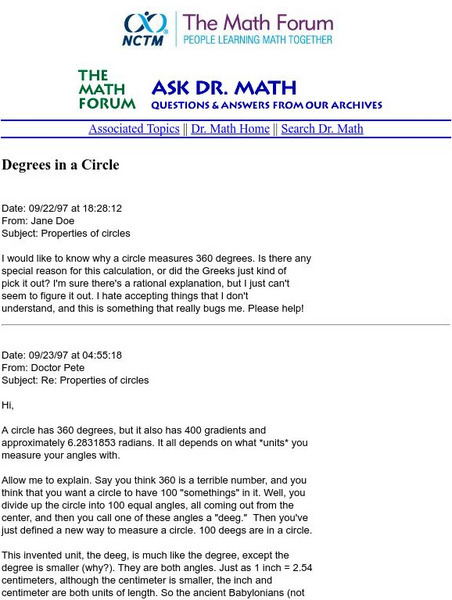Curated OER
Globe Skills Lesson 3 Voyage to the New World
Middle schoolers explore the globe. In this globe skills lesson, students use their knowledge of latitude and longitude to respond to questions regarding Christopher Columbus's maiden voyage to the Americas.
Curated OER
Angle Land and Angle Aerobics
Sixth graders investigate different types of angles. In this geometry lesson, 6th graders use a protractor to identify acute, obtuse, and straight angles.
Curated OER
The Statistics of M&Ms
Students explore the topic of statistics with M and Ms. In this math lesson plan, students use candy pieces to sort and gather information needed to create a bar graph. This lesson can be adapted to accommodate students in grades 1-12.
Curated OER
Radians, Arc Length, and the Area of a Sector
In this college level geometry worksheet, students convert between degrees and radians. Students determine arc length and solve problems involving the area of a sector. The four page worksheet contains seventy-four...
Curated OER
How Many?
In this how many activity, students answer how many are in a pair, dozen, weekend, tandem, and other numbers. Students complete this for 10 problems.
Curated OER
Orienteering II
Students name the parts of a compass and comprehend the function of each part. They define paces and tallies and use them in a real world situation. Students are shown the proper use of radio terminology. They use a map and compass to...
Curated OER
Measuring Angles
Third graders describe an amount of turn from a particular position to another using the 'circular' benchmarks of 0, ++, ++, ++, and full turn. Estimation language such as 'just about', 'between', 'not quite', 'just over', and similar...
Curated OER
Graph Both Crusts
Fourth graders calculate the angles and construct a pie graph of the percentages of the elements in the continental and oceanic crusts. Then they analyze the results. They can be assigned the task of researching the percentages.
Curated OER
Mathematics Within: Shape, Space & Measurement
Young scholars experiment and analyze triangulation to assess degrees of combined angles, predict polygons that tessellate as well as extending of shapes to create tessellations. They explore the concept of why some polygons tessellate...
Curated OER
Building Bridges
Students identify the different types of bridges. Using the internet, they research information on how they are built by completing a scavenger hunt. Locating a specific area, they determine which type of bridge would be appropriate and...
Curated OER
Orienteering I
Learners are introduced to compass work. They name the parts of a compass. Students describe how the parts of a compass are used. They are shown the proper way to hold a compass. Learners are shown that-a-way arrow and its purpose.
Curated OER
Tessellations: Use Angles To Show That Shapes Will or WIll Not Tessellate
Learners observe a selection of shapes. They identify which shapes will tessellate and justify their answer. Students apply the symmetry and angle properties of polygons to create tessellations.
Curated OER
Clocks and Time
Students construct clocks and then learn how to read a clock face, tell time, and determine how much time has elapsed.
Curated OER
Artistic Angles
Fifth graders explore angles by using protractors. They recognize, describe and determine the surface area and volume of three-dimensional shapes. Students recognize the right angle, acute angle, obtuse angle and vertex. They identify...
Curated OER
Parallax
Young scholars discover how astronomers used the diameter of the Earth's orbit around the Sun as a baseline for estimating the distance of some stars, and the meaning of "Parsec" and "light year."
National Council of Teachers of Mathematics
The Math Forum: Ask Dr. Math: Degrees in a Circle
Dr. Math answers a students question as to why a circle contains 360 degrees.
Mathigon
Mathigon: Geometry: Circle and Pi: Degrees and Radians
Rather than dividing a circle into some number of segments (like 360 degrees), mathematicians often prefer to measure angles using the circumference of a unit circle - a circle with radius 1. This way of measuring angles is called...
PBS
Pbs Learning Media: What's a 360?
In this Cyberchase video segment, Harry tries to snowboard and learns how to measure and identify many common angles.
Countries and Their Cultures
Countries and Their Cultures: Assyrians
Ancient Assyrians were inhabitants of one the world's earliest civilizations, Mesopotamia, which began to emerge around 3500 B . C . The Assyrians invented the world's first written language and the 360-degree circle, established...

















